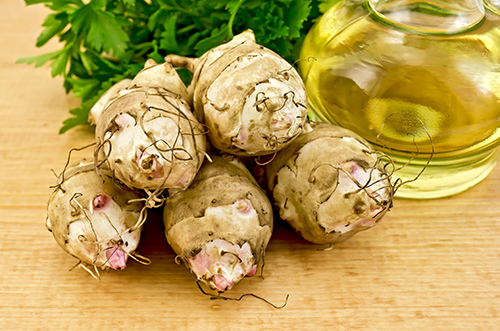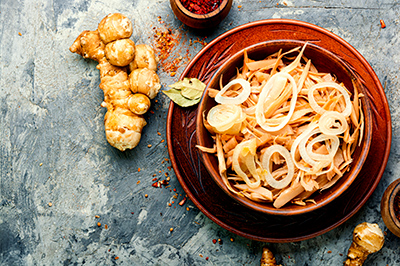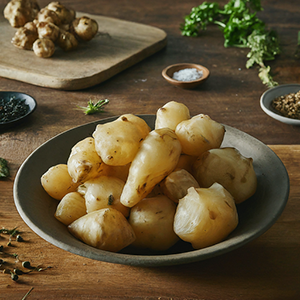Contents
Before the use of the potato from Peru had spread across Europe in the 18th century, the tubers of the Jerusalem artichoke were much appreciated in the Old World. In modern times, they have been displaced by the noble potato, and few now know the flavor and texture of this vegetable of antiquity.

Scientific Facts
- Scientific name – Helianthus tuberosus L.
- Other names – Sunchoke.
- French – Topinambour.
- Spanish – Aguaturma, tupinambo.
- German – Topinambur.
- Description – A tuber of the herbaceous plant of the botanical family Compositae, it belongs to the same genus as the common sunflower.
- Environment—In earlier times, they were grown throughout Europe. They are highly cold-resistant, both as plants and as harvested vegetables. Today, they are used as fodder for cattle and may grow wild in fields once cultivated.
Jerusalem Artichoke Benefits

As their roots, the Jerusalem artichoke’s tubers contain many carbohydrates, among which inulin is notable. People with diabetes very well tolerate this carbohydrate. Jerusalem artichokes contain no glucose. Their protein content is about two percent, the same as the potato. Its minerals include iron and potassium. Jerusalem artichokes are particularly indicated in the following cases:

DIABETES – Because of their hydrocarbon content, Jerusalem artichokes are highly suitable for a diabetic diet.
The elderly, children, and recovery since they are very easily digested.
GOUT, since they contain virtually no protein and do not produce uric acid.
How to Use and Prepare Jerusalem Artichoke
- RAW, in salads – Its texture is smooth and crisp, like radish.
- COOKED—They may be prepared as boiled, fried, or pureed potatoes. Their flavor is reminiscent of artichoke hearts, hence the name.
DISCLAIMER: All content on this website is presented solely for educational and informational objectives. Do not rely on the information provided as a replacement for advice, diagnosis, or treatment from a qualified medical expert. If you are pregnant, nursing, or have any preexisting medical concerns, talk to your doctor before using any herbal or natural medicines.
REFERENCES
- George D. Pamplona-Roger, M.D. “Encyclopedia of Foods and Their Healing Power.” George D. Pamplona-Roger, M.D. Encyclopedia of Foods and Their Healing Power. Trans. Annette Melgosa. Vol. 2. Chai Wan: Editorial Safeliz, 2005. 300. Print.
- Journal of Agricultural and Food Chemistry: https://pubmed.ncbi.nlm.nih.gov/19473054
- USDA Food Composition Database: https://fdc.nal.usda.gov/fdc-app.html#/food-details/169108/nutrients
- Journal of Medicinal Food: https://pubmed.ncbi.nlm.nih.gov/24611926
- Journal of Food Science: https://pubmed.ncbi.nlm.nih.gov/25711326
